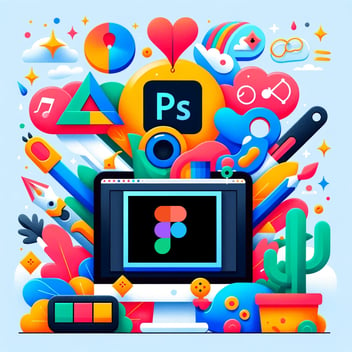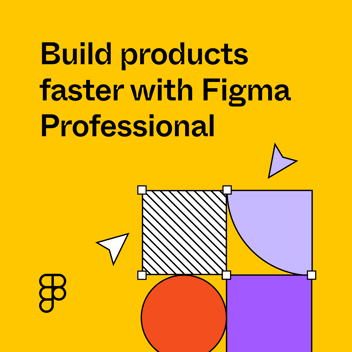
Is Figma Worth The Hype? A Frontend Web Developer Perspective
This post may contain affiliate links, which means I may receive a commission if you click a link and purchase something that I have recommended. Thank you!
Hey there! So, you've heard the buzz about Figma and are wondering what's all the hype? Let's dive into why Figma is becoming the go-to for web devs and designers alike, and why it should probably be on your radar too.
Who Am I? Why Does My Opinion Matter?
My name is Marcus Zeal, and I've been navigating the waters of web development since 2009 when I built my first website. I began as a designer, leveraging tools like Dreamweaver to bridge the gap between design and development. These days, as a developer specializing in creating stunning web experiences, I'm crafting child themes for the WordPress theme Divi and custom templates for HubSpot CMS customers. My journey through both design and development worlds has given me a unique perspective on what tools genuinely transform our workflow—and before Figma, nothing quite cut it. Goodbye Photoshop, hello Figma!
Figma for Web: Revolutionizing Web Development and Design
Imagine a design tool that's so intuitive and flexible, it feels like it was crafted just for you. That's Figma. This cloud-based platform is a game-changer for bringing developers and designers onto the same page — literally. With Figma, collaboration isn’t just a buzzword; it’s the core of your design and development process, making it essential for web developers looking to streamline their workflow.
But what sets Figma apart isn't just its collaboration features. It's how it seamlessly integrates into the developer's workflow. We're talking about a tool that lets you inspect, edit, and export assets without ever leaving your browser. No more miscommunication, no more waiting for the designer to wake up on the other side of the globe to send you that asset you need ASAP.
Why Web Developers Advocate for Figma: Insights into Developer Handoff
For my fellow devs, Figma is like the Swiss Army knife we didn’t know we needed. Its Dev Mode offers a backstage pass to the design world, presenting assets in a developer-friendly format. This significantly simplifies the developer handoff, ensuring we spend less time deciphering design intents and more time coding.
And the learning curve? Practically flat. Figma wants you to explore, play around, and get your hands dirty. From animations that bring your interfaces to life to mastering the grid system that makes layouts a breeze, Figma’s got tutorials and resources that feel more like a fun afternoon project than a steep learning hill.
Figma: Trusted by Teams for Collaborative Web Design and Development
Figma turns the dream of real-time, collaborative web design and development across time zones into reality. It integrates seamlessly with tools like Slack, making it a powerhouse for developers and designers seeking to innovate together. This synergy not only makes Figma an invaluable part of your toolkit but also the heart of creating responsive, device-agnostic web experiences.
This shared environment Figma creates isn’t just about making things easier; it's about making them better. By bringing everyone into the loop from the get-go, you’re not just designing alongside your team; you’re innovating together.
Bridging Worlds with Developer Handoff
Remember the days when handing off a design felt like playing broken telephone? Those days are over. Figma’s Dev Mode is like having a translator for designer-speak, offering up a clear view of what needs to be built. This direct line to the design system means you’re spending less time guessing and more time creating.
With tools that lay everything out for you—from component properties to design tokens—Figma doesn’t just hand you a design; it hands you the blueprint to build it.
Getting Down to Web Business
But here’s the real kicker: Figma knows the web. It's not just about pretty pictures; it's about creating designs that work across every device, every time. Responsive design isn’t an afterthought; it’s at the core of what Figma does, ensuring your web applications not only look the part but play it too, no matter where they’re viewed.
Using Figma means you’re not just keeping up with the web; you’re setting the pace. With tools that let you animate, adapt, and bring your designs to life, Figma isn’t just a part of your toolkit; it’s the heart of your creative process.
Core Figma Features for Web Warriors
Alright, squad, let’s roll up our sleeves and dissect the core features of Figma that make it the Swiss Army knife for web devs. We're talking about the kind of tools that not only streamline our workflow but also kindle our creative sparks.
Mastering Figma for Developers: Navigating the Interface with Ease
Figma's interface? It's like the cockpit of a spacecraft – but one you know how to fly instinctively. It's designed with the precision of a Swiss watch, ensuring that whether you're a seasoned pilot or a first-time flyer, you've got everything you need within arm's reach. Zooming in, switching views, or finding that pesky layer buried in your project? It’s all a breeze. This interface is your playground, and Figma made sure you’d feel right at home.
Dev Mode: A Gateway to Efficient Development
Enter Dev Mode, Figma's secret tunnel between design and development. It's not just about peeking at the design specs; it's about transforming those specs into the language we dream in – code. Imagine clicking on an element and getting its CSS properties handed to you on a silver platter. Integrations with your daily tools? They’ve thought of that too. Dev Mode is like having a translator that speaks designer and developer fluently, making sure nothing gets lost in translation.
Is it perfect? Definitely not. Is the CSS always just a quick and easy copy-paste? hahahahahaahahahaha.. no. But it does give you CSS and if you did just copy paste all of it, you'd have something. In fact, there are entire site suite integrations like Relume.io that can just spit out your entire Figma into Webflow if designed a certain way.
It's good... Shoot, I'd say it's even great! But it's not perfect. Yet. And thank goodness because us developers still need a job! ;)
Optimizing Workflow with Figma’s Component Library for Streamlined Development
Ever felt like you're reinventing the wheel with each project? Figma’s component library puts an end to that. Create a button once, and use it everywhere. Need to tweak it? Change it once, and it updates across your entire project. This is about working smarter, not harder. It's about creating your own building blocks and assembling them into something unique every time. Figma’s component library is like your personal Lego set, but for web development.
Responsive Design Tools for a Multi-Device World
We live in a world where your website could be viewed on a fridge – seriously. That’s where Figma’s responsive design tools come into play. They're not just about making sure your site fits on every screen; they're about making it shine on every device. Grids, constraints, and breakpoints are your best friends, ensuring your design is as fluid as the world we're designing for. With Figma, responsive design is not just a feature; it’s a philosophy.
Seamless Developer Handoff: Leveraging Figma’s Comprehensive Design Systems
Gone are the days of endless back-and-forths with designers. Figma’s comprehensive design systems mean you’ve got everything from colors to typography at your fingertips, ready to be implemented. It’s about ensuring that the handoff is so seamless, you'll wonder if you've started thinking like a designer. Or maybe, they’ve started thinking like us. Either way, Figma makes sure we’re all speaking the same language, making collaboration not just possible, but effortless.
Best Practices? Got 'Em
Alright, team, let's shift gears and talk shop about how to truly leverage Figma in our web development adventures. This isn't just about knowing the tools; it's about wielding them like a web warrior ready for battle. So, how do we use Figma to not just survive but thrive in the digital frontier? Buckle up, because we're diving deep.
Dive Into the Figma Community
First off, if you're flying solo or even if you're part of a squadron of devs, tapping into the Figma community is like finding your tribe. This free online web haven is brimming with templates, plugins, and wisdom from fellow web developers who've been in the trenches. Whether you need a quick tutorial, a specific frame, or just some design file inspiration, the Figma community has got your back. It's about sharing the load and learning from the collective brainpower of designers and developers worldwide.
Master the Art of Developer Handoff
Developer handoff can feel like trying to decipher an ancient scroll unless you're using Figma. Here’s the deal: make Dev Mode your best friend. This isn’t just a flashy feature; it’s your gateway to seamless design and development integration. By exploring features for web in Dev Mode, you’re not just inspecting; you’re understanding. You'll see how the full design translates into code, pick up on the nuances of typography, and even how animation can be replicated in CSS or JavaScript.
Get Your Hands Dirty with Tutorials
You know what they say, "Practice makes perfect." And Figma’s got tutorials that'll make you want to learn everything from crafting a pixel-perfect icon to animating UI elements that make users go "Wow!" Don't just skim the surface; dive into these resources. The more you explore Figma for web development, the more you'll uncover tricks that'll save you time, elevate your designs, and maybe even impress your designer buddies.
Automate to Innovate
Let's talk automation because, let's face it, we’d all rather be sipping a cold one than manually exporting assets, right? Figma’s plugin library is your ticket to efficiency. From automating repetitive tasks to converting your designs into a neatly packaged code snippet, there's probably a plugin for it. And if there isn’t, why not flex those coding muscles and create one?
Embrace the Design System
Lastly, if Figma were a kingdom, then the design system would be its crown jewels. This isn’t about stifling creativity; it’s about creating a shared language across your team. By developing a robust design system, you ensure consistency, streamline your workflow, and reduce those pesky inconsistencies that can throw a wrench in the works. And with Figma, managing this system is a breeze, making sure everyone, from frontend to backend, is singing from the same hymn sheet.
Conclusion: Figma, the Unseen Hero of Web Dev
Figma isn’t just a design tool; it's a revolution in web development. It bridges the gap between design and development, ensuring that we're not just building websites but crafting experiences. By integrating Figma into your web development process, you’re setting yourself up for success, ready to create more stunning, user-friendly websites than ever before.
Stay creative, stay curious, and let Figma be the wind beneath your web development wings.
Frequently Asked Questions
Is Figma Free?
Yes, Figma offers a free tier that's incredibly generous. This plan allows individual users and small teams to access many of Figma’s powerful features, including creating and collaborating on designs. For more advanced features and larger teams, paid plans are available.
Is Figma good for web development?
Absolutely! Figma is a game-changer for web development. Its collaborative, cloud-based environment allows for seamless design-to-development workflows. Features like auto layout, constraints, and the ability to inspect code directly make it an invaluable tool for building responsive and visually compelling websites.
Can developers use Figma?
Yes, developers can, and should, use Figma. It's not just a design tool but a bridge between design and development. Developers can access design specifications, export assets, and collaborate with designers in real time. Figma’s Dev Mode provides an easy way for developers to get the information they need to turn designs into functional products.
What website builder works best with Figma?
Several website builders integrate well with Figma, but Webflow is often cited as a great companion due to its visual development interface and the ability to directly import Figma designs. Plugins and third-party tools like Figma to HTML and Relume Library can also facilitate transferring designs from Figma into other platforms like WordPress, Shopify, or even custom HTML/CSS code.
Do developers need a Figma license?
Developers will need access to Figma to fully leverage its capabilities for web development projects. The free version may suffice for individuals or small teams, but larger teams or those requiring advanced features might need a paid subscription. Collaborating with a team that already has a Figma subscription can also provide developers with the access they need.
Can Figma be used for coding?
While Figma itself is not a coding environment, it significantly aids the coding process. Developers can use Figma to inspect designs, extract CSS, iOS, and Android code, and understand layout properties. This makes translating design into code much more straightforward. However, actual coding will still need to be done in a separate development environment.
Can you convert Figma to a website?
Yes, with the right tools and plugins, Figma designs can be converted into functional websites. Tools like Figma to HTML, Anima, and Relume Library can automate much of this process, though manual adjustments are often necessary to ensure the website meets all technical and accessibility standards.
Can you prototype a website in Figma?
Yes, Figma excels at prototyping. Users can create interactive prototypes that simulate the functionality of a website, including transitions, animations, and hover states. This feature allows teams to test and refine user experiences before any code is written, saving time and resources in the development process.


